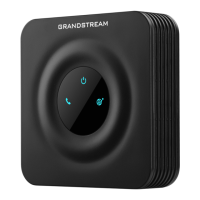3. Launch the TFTP server and go to the File menu→Configure→Security to change the TFTP server's
default setting from "Receive Only" to "Transmit Only" for the firmware upgrade.
4. Start the TFTP server and configure the TFTP server in the phone’s web configuration interface.
5. Configure the Firmware Server Path to the IP address of the PC.
6. Save and Apply the changes and reboot the HT801/HT802.
End users can also choose to download a free HTTP server from http://httpd.apache.org/ or use
Microsoft IIS web server.
Firmware and Configuration File Prefix and Postfix
Firmware Prefix and Postfix allows device to download the firmware name with the matching Prefix and
Postfix. This makes it the possible to store all of the firmware with different version in one single directory.
Similarly, Config File Prefix and Postfix allows device to download the configuration file with the matching
Prefix and Postfix. Thus, multiple configuration files for the same device can be stored in one directory.
In addition, when the field “Check New Firmware only when F/W pre/suffix changes” is set to “Yes”, the
device will only issue firmware upgrade request if there are changes in the firmware Prefix or Postfix.
Managing Firmware and Configuration File Download
When “Automatic Upgrade” is set “Yes, every” the auto check will be done in the minute specified in this
field. If set to “daily at hour (0-23)”, Service Provider can use P193 (Auto Check Interval) to have the
devices do a daily check at the hour set in this field with either Firmware Server or Config Server. If set to
“weekly on day (0-6)” the auto check will be done on the day specified in this field. This allows the device
periodically to check if there are any new changes need to be taken on a scheduled time. By defining
different intervals in P193 for different devices, Server Provider can spread the Firmware or Configuration
File download in minutes to reduce the Firmware or Provisioning Server load at any given time.
Configuration File Download
Grandstream SIP Devices can be configured via the Web Interface as well as via a Configuration File
(binary or XML) through TFTP, FTP/FTPS or HTTP/HTTPS. The Config Server Path is the TFTP,
FTP/FTPS or HTTP/HTTPS server path for the configuration file. It needs to be set to a valid URL, either
in FQDN or IP address format. The Config Server Path can be the same or different from the Firmware
Server Path.
A configuration parameter is associated with each particular field in the web configuration page.
A parameter consists of a Capital letter P and 2 to 3 (Could be extended to 4 in the future) digit numeric
numbers. i.e., P2 is associated with the "New Password" in the Web GUI→Maintenance→Web/SSH
Access page→Admin Password. For a detailed parameter list, please refer to the corresponding firmware
release configuration template.

